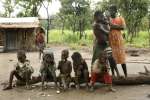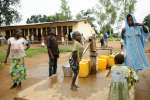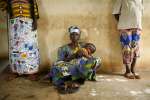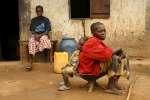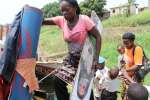UNHCR condemns attacks on camps in Central African Republic
News Stories, 12 November 2015
GENEVA, Nov 12 (UNHCR) – The UN refugee agency has condemned spreading violence around the volatile Central African Republic in recent days, including attacks on two camps for Internally Displaced People (IDP) that killed eight people and the fatal shooting of a UN peacekeeper from Cameroon.
Armed men, presumed to be former Seleka rebels, attacked an IDP site in the central city of Bambari on Thursday (November 12), killing three people, wounding more than 30 and burning some 40 shelters, according to provisional reports. A day earlier, armed men assumed to be former rebels, killed two students in the city.
On Tuesday (November 10), rebel fighters entered the Batangafo camp, reportedly to avenge the killing of two young Muslim men earlier that day in the same camp. They fired shots and torched huts and community shelters, triggering panic and killing five people, according to a preliminary report.
The dead included an elderly woman burnt to death in her shelter. Some 5,500 people fled the camp and sought shelter in safer areas near a camp for UN peace-keepers and the compound of Médecins Sans Frontières. About 730 huts were destroyed in the attack along with a youth centre.
Following that outbreak of violence, a peacekeeper from Cameroon was shot dead in an attack on a checkpoint of the UN stabilization mission (MINUSCA). That attack was condemned by the UN Security Council, which called on authorities to investigate it and bring those responsible to justice.
Last Friday, an attack on the village of Awatche, some 25 kilometres from Bambari, forced some 900 people to flee to a UNHCR-run camp housing 1,850 Sudanese refugees in Pladama Ouaka.
"We strongly condemn these horrific acts that have cost the lives of innocent people. We call on all actors to restore calm and respect the civilian and humanitarian character of IDP camps," said Charles Mballa, UNHCR's Deputy Representative to CAR. "We all have a shared responsibility to protect civilians and preserve the neutrality and security of safe havens," he added.
The events in Batangafo are another reminder that any incident can trigger spiralling violence. Despite relative calm since January 2015, the capital Bangui has been severely affected by violence since September 26, when armed clashes left at least 90 people dead and forced more than 40,000 people to flee to safer areas following the killing of a Muslim taxi driver.
Until the latest violence, the Central African Republic had an internally displaced population estimated at 399,000 (as of mid-October), while almost 460,000 had fled to neighbouring countries.



















